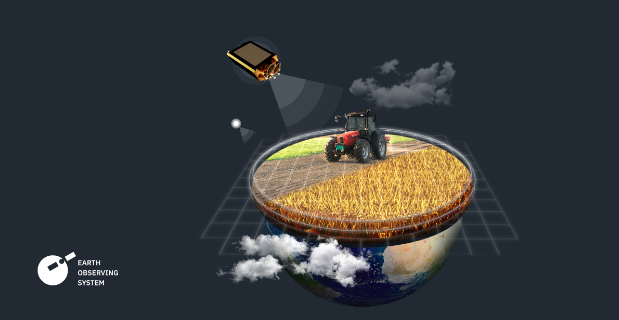Investment in technology is among the growth factors of the Brazilian agriculture sector, besides increasing global food demand and high commodity prices. The county significantly increased farm production without greatly expanding land use. For instance, its grain yields grew nearly 50 percent over the past two decades.
Remote sensing and advanced data analytics are technologies farmers can introduce to manage fields efficiently and timely respond to such weather extremes as droughts that threaten crop yields even in countries with favorable climate conditions like Brazil.
Remote sensing entails detecting and monitoring the physical characteristics of an area of interest by measuring its reflected and emitted radiation at a distance, notably with optical satellites generating image data.
Lina Yarysh, Director of Customer Success at EOS Data Analytics. Photo: EOS Data Analytics
"Remotely sensed images of cultivated lands are further processed and analyzed to extract applicable insights about the state of crops and farming activities - information growers need to manage their farms and, thus, earn more. Insights can include plant growth stages and health, weed infestation, soil moisture levels, weather forecasts, or extreme states that can affect crop growth - heat and cold stress, and more," says Lina Yarysh, Director of Customer Success at EOS Data Analytics.
While satellites provide data for field monitoring, machine learning (ML) is an effective method for interpreting it. EOS Data Analytics, a global provider of AI-powered satellite imagery analytics, uses ML in custom and off-the-shelf solutions, such as EOS Crop Monitoring.
The power of machine learning and deep learning with neural networks for solving agricultural problems
Machine learning is a data science discipline that focuses on creating algorithms that learn from data, identify patterns without human intervention, and gradually improve their accuracy at solving tasks. These algorithms excel in analyzing and interpreting large volumes of data.
Deep learning is a subfield of machine learning that uses complex (deep learning) algorithms with neural network architectures. These algorithms are called artificial neural networks (ANNs) since their architecture is inspired by the neurological structure of the human brain. ANNs easily solve image recognition (classification) tasks - identify what is depicted in images and distinguish one object from another, for instance, detecting weeds and early stages of diseases in coffee plants. The most popular architecture for image recognition and detection tasks is a convolutional neural network. EOS Data Analytics products are also powered by this deep learning algorithm.
But how does a neural network know what object to look for in an image and how to recognize a specific object among others? Data scientists train it by letting it process training data - images examples of these objects where each image is labeled (annotated) with a category it belongs to: water or a land cover, manioc or soybean, etc. That way a neural network learns an objects' visual characteristics needed for its recognition.
"Data scientists can enable a neural network to solve any classification problem as long as they collect and prepare necessary training data. Below we'll discuss one such task EOSDA solved for a customer in Brazil," says Lina Yarysh, Director of Customer Success at EOS Data Analytics.
Free webinar: Learn more about how neural networks can be used to transform satellite data into actionable insights. Video: EOS Data Analytics
Sugarcane classification: detection of sugarcane mills and area estimation
The project included two tasks: classification of sugarcane mills in Brazil and detection of harvested sugarcane (in other words, defining how many hectares of this crop are gathered) on a given date in Brazil's São Paulo state.
Sugarcane fields in Brazil whose images were analyzed within the project (the alt text is for the English version only). Image: EOS Data Analytics
Using mill classification, farmers can understand the amount of available sugarcane and the yield potential of mills when exploring new arable lands or expanding to other markets of potential sugarcane production.
Information about harvested sugarcane (raw material) is valuable for planning field works, defining warehouse capacity, and logistics planning.
For sugarcane mill classification, the EOS Data Analytics team used ground truth data covering 1,000,000 hectares and images from Sentinel-1, Sentinel-2, and MODIS-Terra satellites to create a dataset for labeling and deep learning model training.
The team tested two models: Conv-LSTM model and bidirectional recurrent neural networks based on LSTM. The highest accuracy (more than 94%) was achieved with a Conv-LSTM model. It has the benefits of convolutional (CNN) and long short-term memory (LSTM) networks and permits analyzing spatial time series data.
Classification map based on Conv-LSTM model architecture (violet areas represent sugarcane). Image: EOS Data Analytics
The second task was to detect harvested field index (status) for 6,500 fields. The index means the ratio between the harvested and the entire field's area. Three statuses were used: fully and partially harvested and not harvested. The total area of fields was 47,000 ha.
Specialists used Sentinel-1 Single Look Complex radar and Sentinel-2 optical imagery obtained over consistent time intervals. Optical data was analyzed with NDVI, and sharp drops in its values followed by low index values for a long period of time indicated harvested field plots.
Data scientists provided reports on the harvesting status every 10 days. They also identified several harvesting dates for 10% of field plots, corresponding to the progressive harvest.
Satellite remote sensing and neural network approaches to satellite data analysis take field management to the next level. Neural networks are great at solving real-life problems of agricultural users: crop and land cover classification, detection of harvested field status, verification of pests and diseases, and many more. EOSDA specialists can solve classification tasks for any area of interest as it has nine data sources that provide global coverage and have a high temporal resolution.
* This is a contributed article and this content does not necessarily represent the views of sciencetimes.com














![Earth's Quasi-Moon Kamo‘oalewa Could Originate From Lunar Surface Not Asteroid Belt [Study]](https://1721181113.rsc.cdn77.org/data/thumbs/full/53275/258/146/50/40/earths-quasi-moon-kamo-oalewa-could-originate-from-lunar-surface-not-asteroid-belt-study.png)
